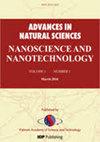MoS2/WSe2 范德华纳米结构中的耦合和界面效应
IF 2.1
Q3 MATERIALS SCIENCE, MULTIDISCIPLINARY
Advances in Natural Sciences: Nanoscience and Nanotechnology
Pub Date : 2023-11-15
DOI:10.1088/2043-6262/ad08a2
引用次数: 0
摘要
在这项研究中,我们报告了准二维 MoS2/WSe2 范德瓦尔斯纳米结构中界面耦合、有效质量、哈特里势和交换相关势对总能量的影响。在没有自洽计算的情况下,确定了总能量作为载流子密度和有效质量函数的分析和数值解。计算仔细表明了准二维电子气是如何从 MoS2 和 WSe2 层之间的界面耦合中产生的。此外,计算结果还表明,随着电子密度的增加,波函数的宽度和两种材料界面之间的长度尺度会减小,而相应的基态量子化能量在 z 方向上会显著增加。此外,在密度为 ns = 4 × 1012 cm-2 的 MoS2 层中,这种额外的分离约为 2 nm,〈z〉 = 1 nm。由于 MoS2 中电子和空穴的有效质量不同,大部分过剩能量被电子吸收为动能。与现有实验和 DFT 计算的比较表明,本研究成果正确地再现了 MoS2/WSe2 界面的已知结果。本文章由计算机程序翻译,如有差异,请以英文原文为准。
Coupling and interface effects in MoS2/WSe2 van der Waals nanostructure
In this work we report the effects of the interface coupling, the effective mass, the Hartree and exchange–correlation potential on the total energy in quasi-2D MoS2/WSe2 van der Waals nanostructure. Analytical and numerical solutions of the total energy as a function of carrier density and effective mass are determined without self-consistent calculation. The calculation carefully indicates how the quasi-2D electron gas arises from the interface coupling between MoS2 and WSe2 layers. Moreover, the results showed that the width of the wave function and the length scale between the two materials’ interface decrease with increasing electron density while the corresponding ground state quantisation energy in the z-direction increases considerably. Furthermore, in MoS2 layer with density n
s = 4 × 1012 cm−2 this additional separation is approximately 2 nm and 〈z〉 = 1 nm. Due to the disparity in effective mass of electrons and holes in MoS2, the majority of the excess energy is absorbed as kinetic energy by electrons. The comparison with available experimental and DFT calculation indicates that the present work reproduces properly known results for MoS2/WSe2 interface.
求助全文
通过发布文献求助,成功后即可免费获取论文全文。
去求助
来源期刊

Advances in Natural Sciences: Nanoscience and Nanotechnology
NANOSCIENCE & NANOTECHNOLOGYMATERIALS SCIE-MATERIALS SCIENCE, MULTIDISCIPLINARY
自引率
4.80%
发文量
0
 求助内容:
求助内容: 应助结果提醒方式:
应助结果提醒方式:


